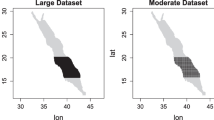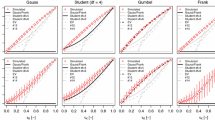Abstract
In this article, we propose a spatial model for analyzing extreme rainfall values over the Triveneto region (Italy). We assess the existence of a long-term trend in the extremes. To integrate data coming from the different stations, we propose a hierarchical model. At the first level, for each monitoring station we model data by making use of a generalized extreme value distribution; at the second level, we combine results from the first stage by exploiting recent advances in modeling nonstationary spatial random fields.
Similar content being viewed by others
References
Besag, J., Green, P., Higdon, D., and Mengersen, K. (1995), “Bayesian Computation and Stochastic Systems,” Statistical Science, 10, 3–41.
Bloomfield, P. (1992), “Trends in Global Temperatures,” Climatic Change, 21, 1–16.
Brooks, S. P., and Gelman, A. (1998), “General Methods for Monitoring Convergence of Iterative Simulations,” Journal of Computational and Graphical Statistics, 7, 434–455.
Casson, E., and Coles, S. G. (1999), “Spatial Regression Models for Extremes,” Extremes, 1, 449–468.
Chandler, R. E. (2005), “On the Use of Generalized Linear Models for Interpreting Climate Variability,” Environmetrics, 16, 699–715.
Coles, S. (2001), An Introduction to Statistical Modeling of Extreme Values, London: Springer.
Cooley, D., Nychka, D., and Naveau, P. (2007), “Bayesian Spatial Modeling of Extreme Precipitation Return Levels,” Journal of the American Statistical Association, 102, 824–840.
Eberly, L. E., and Carlin, B. P. (2000), “Identifiability and Convergence Issues for Markov Chain Monte Carlo Fitting of Spatial Models,” Statistics in Medicine, 19, 2279–2294.
Ekström, M., Fowler, H. J., Kilsby, C. G., and Jones, P. D. (2005), “New Estimates of Future Changes in Extreme Rainfall Across the UK Using Regional Climate Model Integrations. 2. Future Estimates and use in Impact Studies,” Journal of Hydrology, 300, 234–251.
Gelfand, A. E., and Sahu, S. K. (1999), “Identifiability, Improper Priors, and Gibbs Sampling for Generalized Linear Models,” Journal of the American Statistical Association, 94, 247–253.
Gelman, A., Meng, X. L., and Stern, H. (1996), “Posterior Predictive Assessment of Model Fitness via Realized Discrepancies,” Statistica Sinica, 6, 733–807.
Gelman, A., and Rubin, D. B. (1992), “Inference from Iterative Simulation using Multiple Sequences,” Statistical Science, 7, 457–511.
Hall, P., and Tajvidi, N. (2000), “Nonparametric Analysis of Temporal Trend When Fitting Parametric Models to Extreme-Value Data,” Statistical Science, 18, 153–167.
Higdon, D. (1998), “A Process-Convolution Approach to Modelling Temperatures in the North Atlantic Ocean,” Environmental and Ecological Statistics, 5, 173–190.
— (2002), “Space and Space-Time Modeling Using Process Convolutions,” in Quantitative Methods for Current Environmental Issues, eds. C. W. Anderson, V. Barnett, P. C. Chatwin, and A. H. El-Shaarawi, London: Springer, pp. 37–54.
Higdon, D., Swall, J., and Kern, J. (1999), “Non-stationary Spatial Modeling,” in Bayesian Statistics 6, eds. J. M. Bernardo, J. O. Berger, A. P. Dawid, and A. F. M. Smith, Oxford: Clarendon, pp. 761–768.
IPCC (2007), Climate Change 2007: Impacts, Adaptation and Vulnerability, Working Group II Contribution to the Intergovernmental Panel on Climate Change Fourth Assessment Report.
Karl, T. R., Knight, R., and Plummer, N. (1995), “Trends in High Frequency Climate Variability in the Twentieth Century,” Nature, 377, 217–220.
Karl, T. R., and Knight, R. W. (1998), “Secular Trends of Precipitation Amount, Frequency, and Intensity in the United States,” Bulletin of the American Meteorological Society, 79, 231–241.
Katz, R. W., Parlange, M. B., and Naveau, P. (2002), “Statistics of Extremes in Hydrology,” Advances in Water Resources, 25, 1287–1304.
Klein Tank, A. M. G., and Können, G. P. (2003), “Trends in Indices of Daily Temperature and Precipitation Extremes in Europe, 1946–1999,” Journal of Climate, 16, 3665–3680.
Piegorsch, W. W., Smith, E. P., Edwards, D., and Smith, R. L. (1998), “Statistical Advances in Environmental Science,” Statistical Science, 13, 186–208.
Robert, C. P., and Casella, G. (1999), Monte Carlo Statistical Methods, New York: Springer.
Sheather, S. J., and Jones, M. C. (1991), “A Reliable Data-Based Bandwidth Selection Method for Kernel Density Estimation,” Journal of the Royal Statistical Society, Series B, 53, 683–690.
Smith, R. L. (1994), “Spatial Modelling of Rainfall Data,” in Statistics for the Environment 2: Water Related Issues, eds. V. Barnett and F. Turkman, Chichester: Wiley, pp. 19–42.
Smith, R. L. (1999), “Trends in Rainfall Extremes,” Preprint.
Author information
Authors and Affiliations
Corresponding author
Rights and permissions
About this article
Cite this article
Gaetan, C., Grigoletto, M. A hierarchical model for the analysis of spatial rainfall extremes. JABES 12, 434–449 (2007). https://doi.org/10.1198/108571107X250193
Received:
Revised:
Issue Date:
DOI: https://doi.org/10.1198/108571107X250193




